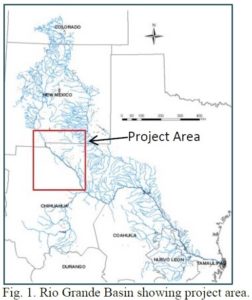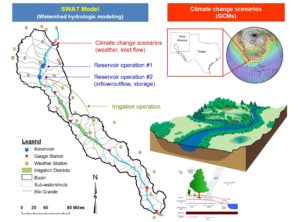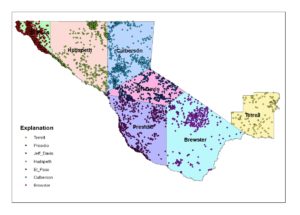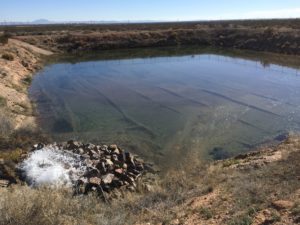Summary
Current Research
- Sustainable Water Resources for Irrigated Agriculture in a Desert River
Basin facing Climate Change and Competing Demands. - Diversifying the Water Portfolio for Agriculture in the Rio Grande Basin
- Transboundary Aquifer Assessment Program – Regional Groundwater Availability Study
- Managed Aquifer Recharge – Powerful Tool for Conjunctive Management of Water Resources
We focus on hydrology in arid regions, and transboundary water resources planning and management. To accomplish this vision, we are committed to
- Excellence in technical research and professional services for the assessment of surface water and groundwater availability
- Using innovative science-based solutions for integrated water resources management
- Encouraging professional development for graduate students and post-doctoral research associates and cooperative partnerships with regional stakeholders, national and international agencies and institutes.
Sustainable Water Resources for Irrigated Agriculture in a Desert River Basin Facing Climate Change and Competing Demands
 This project is funded by USDA-NIFA, led by Dr. William Hargrove of University of Texas at El Paso in collaboration with New Mexico State University, Universidad Autónoma de Ciudad Juarez (UACJ), Texas A&M University, Michigan Tech and University of New Mexico and working with regional stakeholders to gain a better understanding of future scenarios of water availability and use in the Rio Grand project area.
This project is funded by USDA-NIFA, led by Dr. William Hargrove of University of Texas at El Paso in collaboration with New Mexico State University, Universidad Autónoma de Ciudad Juarez (UACJ), Texas A&M University, Michigan Tech and University of New Mexico and working with regional stakeholders to gain a better understanding of future scenarios of water availability and use in the Rio Grand project area.
In spite of dwindling supplies, competing demands, and a changing climate, sufficient water supplies can be achieved and managed to sustain irrigated agriculture in the desert Southwest through innovative technologies, collaborative decision making, and improved policies. Critical components of this complex system include the changing climate which is a crucial driver of water supply and demand, the hydrological connections between surface and groundwater and finally the dynamic bi-national demand for water between the large metropolitan area of El Paso and Ciudad Juarez, the irrigated agricultural area upstream, downstream, and surrounded by the Chihuahuan desert. Using our improved characterization and understanding of the system to develop and test technologies and policies will augment useable water supplies, optimize the allocation of water to competing demands and improve water use efficiency, conservation, and environmental impacts.
Our approach will result in an improved understanding of both stakeholders and researchers of the drivers of water supply and demand. And present acceptable, workable, solutions at a local and regional level. We also plan to develop a dynamic and enduring systems model that can be consulted and adjusted. Ultimately, we want to create transferrable approaches and solutions aimed at the arid/semi-arid basins where irrigated agriculture faces challenges from climate change, competing demands, and salinization. This research will continue to strengthen our universities and research centers to train and develop water professionals.
Fact Sheets:
- Linking Hydrological Models for Watershed Management
- ET Tower Provides Information for Water Conservation
- Evaluation of Irrigation Efficiency Strategies for Far West Texas
- Coordinated Water Resources Databases & GIS for Watershed Management
- Development of RiverWare Model of the Rio Grande Flow for Flood Control and Water Operations Planning
- TAMU and NMSU Scientists Help Irrigation Districts in Water Conservation
Diversifying the Water Portfolio for Agriculture in the Rio Grande Basin
 This project is funded by USDA-NIFA, led by Dr. John Tracy, Director of the Texas Water Resources Institute, and in collaboration with New Mexico State University to explore alternative water sources to sustain agricultural production in the Rio Grande basin.
This project is funded by USDA-NIFA, led by Dr. John Tracy, Director of the Texas Water Resources Institute, and in collaboration with New Mexico State University to explore alternative water sources to sustain agricultural production in the Rio Grande basin.
The long-term goal of this project is understanding how to optimize all available water resources in the Rio Grande Basin for the most significant return. Namely, sustaining agricultural production while enhancing regional water use efficacy, encouraging economic and employment opportunities, and improving ecosystem services.
We first evaluated the current water sources and then looked at the use of water in the following settings: urban, agricultural and the ecosystem. We took into account the changing climate, water management practices, and demographics. Through our research, we are demonstrating the appropriate use of saline and reclaimed water resources across agricultural, municipal and industrial environments and recommending revisions in cropping patterns and agricultural management practices. We are developing research and demonstration tools focused on improving the management of water at all scales (on-farm, M&I systems, canal operation, and irrigation district) within the Rio Grande Basin. Our goal is to identify the most economically efficient use of fresh and marginal water supplies to attain its highest social and agricultural value. Finally, it is essential to broaden outreach, demonstration, teaching, and tools to facilitate the efficient use of all available water resources for regional stakeholders. This research impacts the farmers and water managers in the Rio Grande Basin but will be relevant to similar watersheds in the Southwest United States and other arid regions around the world. We plan to reach out with our results to Regional Water Planning Groups, water managers, and the Extension service to continue knowledge sharing.
Fact Sheets:
- Hydrological Assessment of Salinity in the Pecos River
- Installation of Rio Grande Project Area Monitoring Network
- Rio Grande Salinity Management Preliminary Economic Impact Assessment
- Use of Reclaimed Effluent and Salty Groundwater for Cotton Production
- Water Conservation Through Reuse of Graywater
- Soil Salinity Management Using Synthetic Organic Polymer
Transboundary Aquifer Assessment Program – Regional Groundwater Availability Study
 The United States (US)-Mexico Transboundary Aquifer Assessment Program (TAAP) was established under the 2006 Act (Public Law 109-448) to develop and implement an integrated scientific approach to identify and assess priority transboundary aquifers. The overarching goal of TAAP is to produce scientific products for priority transboundary aquifers that—are capable of being broadly distributed and provide the scientific information needed by water managers and natural resource agencies on both sides of the United States-Mexico border to accomplish the missions of the managers and agencies effectively. Priority aquifers were named in the TAAP Act, and are the Hueco Bolson under Texas and Chihuahua Mexico, the Mesilla/Conejos-Médanos aquifer running underneath New Mexico and Chihuahua Mexico, and the San Pedro and Santa Cruz aquifers under the state of Arizona and Sonora, Mexico.
The United States (US)-Mexico Transboundary Aquifer Assessment Program (TAAP) was established under the 2006 Act (Public Law 109-448) to develop and implement an integrated scientific approach to identify and assess priority transboundary aquifers. The overarching goal of TAAP is to produce scientific products for priority transboundary aquifers that—are capable of being broadly distributed and provide the scientific information needed by water managers and natural resource agencies on both sides of the United States-Mexico border to accomplish the missions of the managers and agencies effectively. Priority aquifers were named in the TAAP Act, and are the Hueco Bolson under Texas and Chihuahua Mexico, the Mesilla/Conejos-Médanos aquifer running underneath New Mexico and Chihuahua Mexico, and the San Pedro and Santa Cruz aquifers under the state of Arizona and Sonora, Mexico.
The USGS Water Science Centers (WSC) and the Water Resources Research Institutes (WRRI) of Texas, New Mexico, and Arizona have worked collaboratively and will continue to work collaboratively under TAAP to achieve common goals by capitalizing on the capabilities and expertise that each organization possesses. The U.S. and Mexican State Departments facilitate bilateral projects and collaboration with Mexican universities and federal agencies such as the National Water Commission. In 2016 TAAP was added as a Regional Groundwater Availability Study under the Water Availability and Use Science Program of USGS.
TAMU Team (John Tracy, Rosario Sanchez, and Zhuping Sheng) focus on the shared aquifers along the US-Mexico border within Texas, including Hueco Bolson and Mesilla Basin aquifers as identified in the original Act.
https://transboundary.tamu.edu/
Fact Sheets:
Managed Aquifer Recharge – Powerful Tool for Conjunctive Management of Water Resources
 TAMU Water Seed Grant: We are teaming with Dr. Gretchen Miller, Department of Civil Engineering of TAMU to develop better methods and guidance for determining the potential local and large scale effects of mixing native groundwater and introduced waters before ASR project development. We are working to demonstrate the impact of subsurface heterogeneity on ASR hydraulics and contaminant transport and providing recommendations on priorities for preliminary site investigation. As well as creating an operations/decision-making module to optimize energy use and enhance recovery fraction in ASR systems based on hydraulics and aquifer properties. This study includes case studies in El Paso and San Antonio in Texas and Belgium.
TAMU Water Seed Grant: We are teaming with Dr. Gretchen Miller, Department of Civil Engineering of TAMU to develop better methods and guidance for determining the potential local and large scale effects of mixing native groundwater and introduced waters before ASR project development. We are working to demonstrate the impact of subsurface heterogeneity on ASR hydraulics and contaminant transport and providing recommendations on priorities for preliminary site investigation. As well as creating an operations/decision-making module to optimize energy use and enhance recovery fraction in ASR systems based on hydraulics and aquifer properties. This study includes case studies in El Paso and San Antonio in Texas and Belgium.
Harris County Flood Control District Drainage Reuse Initiative Feasibility Study (Phases I and II): investigate the feasibility of alternative methods of flood mitigation by conveying stormwater to the subsurface, including natural infiltration into underlying aquifer, enhanced infiltration or injection via drywell into unconfined aquifers and ASR wells into a deep formation.
Fact Sheets:
Publications
- Ahn, S.#, Abudu, S.#, Sheng, Z. and Mirchi, A. (2018). Hydrologic impacts of drought-adaptive agricultural water management in a semi-arid river basin: Case of Rincon Valley, New Mexico, Agricultural Water Management, 209: 206-218. DOI: 10.1016/j.agwat.2018.07.040.
- Zhang N., Li, S., Sheng, Z. (2018). The method for estimating tensile strength by using shear strength parameters and discussion. Journal of Engineering Geology, 26(s): Doi:10.13544/j.cnki.jeg.2018127.
- Abudu, S.#, Sheng, Z., Sabzi, H.Z., King, J.P. (2018). Drought Scenario Analysis Using RiverWare: A Case Study in Urumqi River Basin, China, Civil Engineering Journal 4(8): 1837-1850. DOI: 10.28991/cej-03091118.
- Abudu, S.#, Sheng, Z., Ganjegunte, G. (2018). Assessing Vegetable Growth and Yield Response to Graywater Irrigation. American Journal of Agricultural Research, 2018, 3:19.
- Kong, X.*, Wang, S., Liu, B., Sun, H., Sheng, Z. (2018). Impact of Water Transfer on Interaction between Surface Water and Groundwater in the Lowland Area of North China Plain. 09 May 2018, Hydrological Processes, doi: 10.1002/hyp.13136
- Bushira, K.M*, Gebregiorgis, Y. B., Verma, R.K., Sheng, Z. (2018). Cut soil slope stability analysis along National Highway at Wozeka–Gidole Road, Ethiopia. April 2018, Modeling Earth Systems and Environment. doi: 10.1007/s40808-018-0465-6
- Wang, S., Yuan, R., Tang, C., Song, X., Currell, M., Yang, Z., Sheng, Z. (2018). Combination of CFCs and stable isotopes to characterize the mechanism of surface water-groundwater interaction in a headwater basin of the North China Plain. Hydrological Processes, 32 (11): 1571-1587. doi: 10.1002/hyp.11494.
- Zhang N., Li, X., Sheng, Z. (2018). The new formula of calculating depth of a tension crack in the upper surface of a sliding slope using inflection principle. Journal of Engineering Geology, 26(1): 157-163. doi:10.13544/j.cnki.jeg.2018.01.017.
- Zhang N., Sheng, Z., Qi S. (2018). Noncircular curve searching for determining the minimum safety factor in designing homogenous slope. Journal of Engineering Geology, 26(1): 241-248. doi:10.13544/j.cnki.jeg.2018.01.024.
- He, Y., Chen, X., Sheng, Z., Lin, K., Gui, F. (2018). Water allocation under the constraint of total water use quota: A case from Dongjiang River Basin, South China. Hydrological Sciences Journal, 63(1): 154-167. doi: 10.1080/02626667.2017.1417596.
- Smith, WB., Miller, G.R., Sheng, Z. (2017). Assessing Aquifer Storage and Recovery Feasibility in the Gulf Coastal Plains of Texas. Journal of Hydrology: Regional Studies, 14: 92-108. doi: 10.1016/j.ejrh.2017.10.007
- Bushira, K.M., Hernandez, J.R., Sheng, Z. (2017). Surface and groundwater flow modeling for calibrating steady state using MODFLOW in Colorado River Delta, Baja California, Mexico. Modeling Earth Systems and Environment, 3 (2): 815–824. doi:10.1007/s40808-017-0337-5.
- Sheng, Z., Jia, S. Michelsen, A., Abudu. S. (2017). Lessons learned from long term water resources plans: top town vs. bottom up, XVI World Water Congress, Cancun Mexico, May 29-June 2 [8p].
- Abudu S., Sheng Z., Michelsen A., Rodriguez, O, King J.P. (2016). Evapotranspiration and Crop Coefficient for Pecan Trees in El Paso, Texas, Proc. Irrigation Show and Education Conference, December 4-7, Las Vegas, NV, [8p].
- Abudu S., Sheng Z., He J., Cui C., Bayinmengke. (2016). Prospects on drip irrigation development in Xinjiang, China, Proc. Irrigation Show and Education Conference, December 4-7, Las Vegas, NV, [8p].
- Abudu, S., Sheng, Z., Cui, C., Saydi, M., Zamani-Sabzic, H., King, J.P. (2016). Integration of aspect and slope in snowmelt runoff modeling in a mountain watershed, Water Science and Technology, 9(4): 265-273. doi:10.1016/j.wse.2016.07.002
- Li, Y., Shao, X., Sheng, Z., Guan W., Xiao, M. (2016). Water conservation and nitrogen loading reduction effects with controlled and mid-gathering irrigation in a paddy field. Pol. J. Environ. Stud, 25(3): 1-7.
- Li, Y., Shao, X., Sheng, Z. (2016). Field experiments on reducing pollutants in agricultural-drained water using soil-vegetation buffer strips. Pol. J. Environ. Stud, 25(1): 183-192.
- McDonald, A. K., Wilcox, B.P., Moore, G.W., Hart, C.R., Sheng, Z., Keith Owens M. (2015). Tamarix transpiration along a semiarid river has negligible impact on water resources, Water Resour. Res., 51, doi:10.1002/2014WR016866.
- Sun, G., Michelsen, A., Sheng, Z., Fang, A.F., Shang, Y., Zhang, H. (2015). Featured Collection Introduction: Water for Megacities – Challenges and Solutions, Journal of AWRA, 51(3): 585-588. doi: 10.1111/1752-1688.12317.
- Zhang, N., Sheng, Z. (2015). New analytical solutions for one dimensional steady-state flow in an unconfined aquifer with a sloping base. Journal of Engineering Geology (in Chinese), 23 (SUPPL.): 223-228.
- Sheng, Z. Y. Liu. (2015). Evapotranspiration of flood-irrigated pecans under drought conditions in El Paso, TX, 2015 ASABE Irrigation Symposium, November 12-14, Long Beach, CA, [Peer-Reviewed paper].
- Sheng, Z., & Zhao X. (2014). Special Issue on Managed Aquifer Recharge: Powerful management tool for meeting water resources challenges. Journal of Hydrologic Engineering, 20(3). doi: 10.1061/(ASCE)HE.1943-5584.0001139.
- Ahmed, N., Taylor, S.W., Sheng, Z. (eds.) (2014). Hydraulics of Wells: Design, Construction, Testing, and Maintenance of Water Well Systems, ASCE Manuals and Reports on Engineering Practice No. 127. ASCE, Reston, 498p.
- Abudu, S., Sheng, Z., Cui, C., D. Guan. (2014). The karez system in China’s Xinjiang Region, in John Calabrese (ed.), Harvesting Water and Harnessing Cooperation: Qanat Systems in the Middle East and Asia, Middle East-Asia Project (MAP), Middle East Institute, January 18, 2014, available at: http://www.mei.edu/content/harvesting-water-and-harnessing-cooperation-qanat-systems-middle-east-and-asia.
- Ganjegunte, G.K., Sheng, Z., Clark, J.A. (2014). Soil salinity and sodicity appraisal by electromagnetic induction in irrigated cotton soils. Land Degradation & Development. 25:228-235. doi: 10.1002/ldr.1162.
- Zhang, N., Sheng, Z., Qi, S., He, J., Li S. (2014). Mechanisms and conditions of compression extrusion of a horizontal-dip thin soft rock strata. Journal of Engineering Geology (in Chinese), 22(4): 610-624.
- Gutchick, V.P., Sheng, Z. (2013). Control of atmospheric fluxes from a pecan orchard by physiology, meteorology, and canopy structure: modeling and measurement. Agricultural Water Management, 129: 200-211. doi: 10.1016/j.agwat.2013.08.004
- Liu, Y., Sheng, Z. (2013). Soil moisture statuses in an irrigated pecan field. Journal of Irrigation and Drainage Engineering, 139(1): 26-40.
- McDonald, A.K., Sheng, Z., Hart, C.R., Wilcox, B.P. (2013). Studies of a regulated dryland river: surface-groundwater interactions. Hydrological Processes, 27(12): 1819–1828. doi: 10.1002/hyp.9340.
- Sheng, Z., Fox, G., Abudu, S. (2013). Interconnection of atmospheric water, surface water, and groundwater. Journal of Hydrologic Engineering, 18(10): 1-2
- Sheng, Z. (2013). Impacts of groundwater pumping and climate variability on groundwater availability in the Rio Grande Basin. Ecosphere, 4(1): Art5. http://dx.doi.org/10.1890/ES12-00270.1
- Sheng, Z., Darr, M., King, J.P., Bumgarner, J., Michelsen, A. (2013). Mesilla Basin/Conejos-Médanos Section of the Transboundary Aquifer Assessment Program, in Alley, W.M. (ed.) Five-Year Interim Report of the United States – Mexico Transboundary Aquifer Assessment Program: 2007 – 2012, U.S. Geological Survey Open-File Report 2013–1059, Reston, VA: 19-30.
